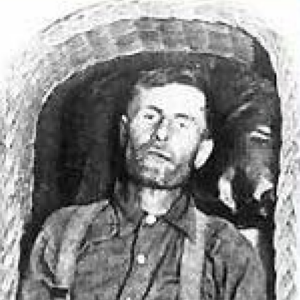Sometimes bizarre things happen to bizarre people.
Our subject spent 31 years wallowing in failure until blundering his way to a bloody demise. Yet, it took a hit TV show to secure his final rest an incredible 66 years later.
This is the story of the strange afterlife of Elmer McCurdy.
He was born New Year’s Day, 1880 to an unwed 17-year-old mother who was never sure who Elmer’s father was. The boy grew into a troubled teen: Sullen, unruly, rebellious. Then he discovered liquor, and everything went downhill from there.
Elmer learned the plumbing trade and drifted around the country in an alcoholic stupor. He’d get a job, lose it because of his drinking, move on, and repeat the process.
In the early 1900s, he wound up working in southwestern Missouri’s lead mines, followed by a hitch in the Army where Uncle Sam trained him to use nitroglycerin in demolitions. (Alcohol and explosives … what could possibly go wrong?)
Back in civilian life, he hooked up with some fellow outcasts in Oklahoma and decided his plumbing, mining and explosives experience made him an ideal criminal.
He started with a train robbery. Elmer used too much nitro on a safe. It blew open all right, but the powerful blast incinerated the cash. The boys made off with only silver coins (some melted by the explosion).
Elmer turned to bank robbery — with predictably disastrous results. Too much nitro (again) destroyed the bank’s main room but didn’t even dent the safe.
His string of failures ended on a spectacularly bad note. On October 4, 1911, he gave train robbery one more shot when he learned a $400,000 payment to the Osage Indian tribe was heading his way. True to form, Elmer and his buddies stopped the wrong train. They got only $46 in cash, two jugs of whiskey, and the conductor’s watch.
Elmer rode off in frustration, holed up in a barn, and drained both jugs. He was roaring drunk when a posse found him. A single bullet ended his bumbling career.
But the end of Elmer McCurdy’s life was just the beginning of his story.
The body was sent to a Pawhuska, Okla., funeral parlor. The undertaker filled it with a strong dose of arsenic, a common practice in a time when weeks or months might pass before relatives claimed the remains.
But no one came for Elmer. To recover the money he’d spent preserving the body, the undertaker turned Elmer into a moneymaker. Billing him as “The Oklahoma Outlaw” and “The Embalmed Bandit,” people paid a nickel to stare at the man who’d found out the hard way that crime doesn’t pay.
It was a lucrative gimmick … until a man showed up five years later saying he was Elmer’s brother. When he asked to take the body to California for burial, the undertaker reluctantly turned it over.
But the “brother” was actually James Patterson, owner of the Great Patterson Traveling Carnival Shows. He’d heard what a popular attraction Elmer’s corpse was and wanted it for his carnival. Patterson lugged it around the country, displaying it as “The Outlaw Who Wouldn’t Be Taken Alive.”
From there, it bounced from one freak show to another. It was briefly used as a display in movie theaters for the 1933 film “Narcotic!” It even found its way into a tourist trap near Mount Rushmore. Because the undertaker had used so much arsenic, Elmer’s carcass became the Energizer Bunny of embalmed bodies; it kept going and going …
Over the decades, various owners came to mistakenly assume the body was a mannequin.
In the 1960s, Elmer wound up in Long Beach, Calif., hanging from a rope in the Laff In The Dark funhouse. Thousands of visitors passed the body, thinking it was just another wax dummy. Until Hollywood came calling.
In 1976, a TV crew was filming scenes for a “Six Million Dollar Man” episode inside the funhouse. A prop man knocked the figure over, breaking off an arm and exposing bone and muscle tissue.
That’s when they called the police.
An autopsy confirmed the mannequin was indeed a human body. After months of research, Elmer was finally identified, making national news on December 11.
Again, no relative claimed the body, so it was eventually turned over to a group called the Indian Territory Posse of Oklahoma Westerns and returned to where Elmer’s post-mortem career began.
On April 22, 1977, 300 people watched as he was buried in the Boot Hill section of a Guthrie, Okla., cemetery beside outlaw Bill Doolin’s grave. Then they poured two feet of concrete on top of the coffin, just to be on the safe side.
Elmer McCurdy won’t be going anywhere for a long, long time.





